Add Beauty to Your Outside Spaces, Attract Pollinators, and Have Access to Natural Remedies
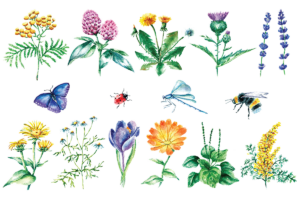 Long before the post-Industrial Revolution emergence of modern (or allopathic) medicine (i.e., the practice of using drugs or surgery, often in conjunction with counseling and lifestyle modifications, to treat health conditions), mankind relied on plants to treat ailments. While the earliest written records on the use of plants for medicinal purposes date back at least 5,000 years to the Sumerians, archeological studies have estimated that the practice of using plants as medicine date as far back as 60,000 years in Iraq and 8,000 years in China.1 Despite its long history of use, however, herbal medicine lacks the rigorous scientific evidence that backs modern medicine practices, which can present challenges to its use among today’s healthcare practitioners and the patients they treat. That’s not to say that medicinal plants have no place or value in today’s healthcare arena. When used under supervision of a qualified healthcare provider, many plants are thought to offer therapeutic properties or beneficial pharmacological effects.2 Here, we describe several plants that may provide you with medicinal benefits while adding beauty and attracting pollinators to your garden.
Long before the post-Industrial Revolution emergence of modern (or allopathic) medicine (i.e., the practice of using drugs or surgery, often in conjunction with counseling and lifestyle modifications, to treat health conditions), mankind relied on plants to treat ailments. While the earliest written records on the use of plants for medicinal purposes date back at least 5,000 years to the Sumerians, archeological studies have estimated that the practice of using plants as medicine date as far back as 60,000 years in Iraq and 8,000 years in China.1 Despite its long history of use, however, herbal medicine lacks the rigorous scientific evidence that backs modern medicine practices, which can present challenges to its use among today’s healthcare practitioners and the patients they treat. That’s not to say that medicinal plants have no place or value in today’s healthcare arena. When used under supervision of a qualified healthcare provider, many plants are thought to offer therapeutic properties or beneficial pharmacological effects.2 Here, we describe several plants that may provide you with medicinal benefits while adding beauty and attracting pollinators to your garden.
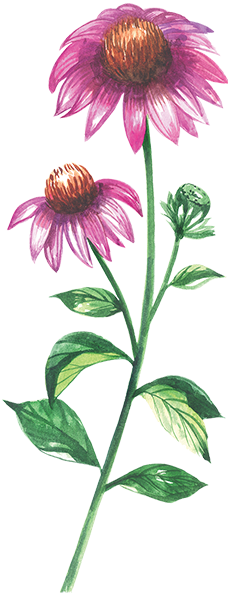 Echinacea purpurea (Purple Coneflower)
Echinacea purpurea (Purple Coneflower)
The purple coneflower, a flowering perennial, is a member of the daisy (asteraceae) family. It produces large, showy flowers in the summer through early fall, usually purple-pink in color, that grow on tall leafy stalks that can reach 2 to 4 feet in height. Purple coneflowers aren’t fussy about where they grow: they thrive in partial shade to full sun and can tolerate moist or dry soil. Butterflies and bees love the large domed center of the coneflower, so growing echinacea is sure to make your garden a destination favorite among the pollinators.3
The flowers, leaves, and roots of the echinacea plant are thought to have antibiotic, antiviral, immune-boosting, and wound-healing properties.4
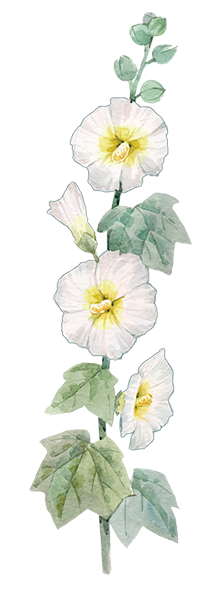 Althea officinalis (Mallow)
Althea officinalis (Mallow)
The mallow plant is a bushy perennial that grows 4 to 5 feet tall. Its dramatic show of blooms from July to September will add beauty to your garden, and the small, delicate, pale pinkish flowers that cover tall, elegant spikes are loved by pollinators. The mallow plant prefers consistently moist or marshy soil, hence its more common name “marshmallow,” and it prefers at least four hours of full sunlight.5
The popular confectionary treat known as marshmallow was initially made from whipping the sap derived from the root of the mallow plant, hence the candy’s name. This practice dates back to 2000 BC with the Egyptians, who would mix the gooey root sap with nuts and honey, creating a treat so special, it was reserved for the gods and royalty. In the 1800s, the French were introduced to marshmallow when French candy makers whipped mallow root sap by hand with egg whites and sugar into a fluffy candy mold. This process was considered very time-consuming, so the French began incorporating cornstarch to speed up the process. Eventually, the mallow root sap was replaced with gelatin, from which today’s marshmallow candy is most commonly derived.6
The mallow leaf and root have traditionally been used to treat stomach ulcers, diarrhea, and constipation.7
 Lavender (Lavendula spp.)
Lavender (Lavendula spp.)
Lavender is a lovely bushy perennial known for its fragrant gray-green leaves and equally fragrant, upright, blue-violet–flowered spikes. It grows 2 to 3 feet in height and width, and makes a great addition to cottage gardens. Its care is uncomplicated, provided the soil is well-drained and its location receives several hours of full sun daily. The flowered spikes can be harvested for fresh flower arrangements, and when dried, remain very fragrant, making them ideal for sachets. Bees love lavender, and hearing their hums of delight as they fly from flower to flower is nearly as relaxing as the soothing medicinal effects for which lavender is known.8
Lavender has traditionally been used to help people fall asleep. Today, the fragrant essential oil derived from its flowers is frequently used in aromatherapy to calm nerves, soothe headaches, promote relaxation, and induce sleep. It is also thought to have some antibacterial properties.9
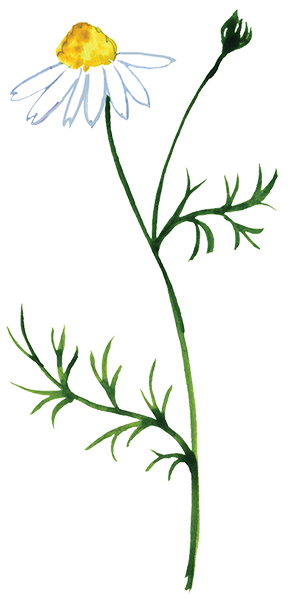 Matricaria recutita (German Chamomile)
Matricaria recutita (German Chamomile)
German chamomile is an aggressively self-seeding bushy annual that grows 8 to 24 inches in height and 8 to 12 inches wide, with small, aromatic, white-petaled, yellow-centered blossoms that resemble daisies. It tolerates light shade to full sun, thrives in well-drained soil, and is considered drought-tolerant. Roman chamomile, on the other hand, is a low-creeping perennial often used as ground cover, with leaves and flowers similar to the German variety. Chamomile does well in containers, though German chamomile requires a container large enough to accommodate its sprawl; Roman chamomile stays a bit more contained. Either type of chamomile will add subtle beauty to the garden, especially when used as a ground cover (Roman) or among rocky areas or rock walls (German).10,11
The flowers of both German and Roman chamomile have been used as an herbal remedy for upset stomach, muscle spasms, mild infections, and as a sleep aid; however, the German variety is considered more potent.12,13
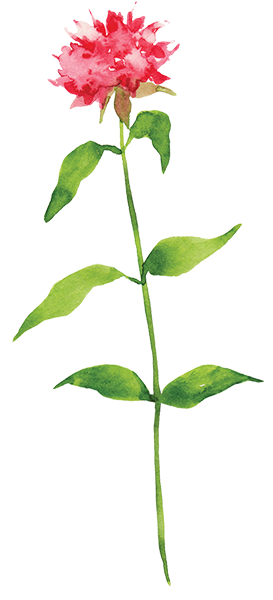 Monarda didyma (Scarlet Beebalm)
Monarda didyma (Scarlet Beebalm)
Scarlet beebalm is a member of the mint family. Beebalm’s common name refers to a resin that can be extracted from the plant that can soothe bee stings. Beebalm is a perennial native to North America and grows up to 3 feet in height. It has vivid dark pink- to scarlet-colored blossoms that erupt from domed flower heads, making it a striking addition to the garden and a favorite among butterflies and hummingbirds. Beebalm grows in partial to full sun and moist, fertile soil. It is a vigorous self-seeder and requires little care.14
Beebalm has traditionally been used as an anti-inflammatory, antispasmodic, and decongestant. It is thought to have antimicrobial and analgesic properties. Beebalm has also been used traditionally to relieve nausea and indigestion.15
Editor’s Note
Seek advice from a qualified healthcare provider before using natural remedies. Always inform your healthcare provider if you are taking any medicinal herbs or using any natural remedies.
Sources
1. Pan S-Y, Litscher G, Gao S-H, et al. Historical perspective of traditional indigenous medical practices: the current Renaissance and conservation of herbal resources. Evid Based Complement Alternat Med. 2014; 2014: 525340.
2. Namdeo A. Cultivation of medicinal and aromatic plants. In: Mandal SC, Mandal V, Konishi T (eds). Natural Products and Drug Discovery: An Integrated Approach. Amsterdam: Elsevier; 2018:525-553.
3. Mount Sinai site. Echinacea. https://www.mountsinai.org/health-library/herb/echinacea#:~:text=Today%2C%20people%20use%20echinacea%20to,help%20the%20body%20fight%20infections. Accessed 28 Mar 2022.
4. Senica M, Mlinsek G, Veberic R, Mikulic-Petkovsek M. Which plant part of purple coneflower (Echinacea purpurea (L.) Moench) should be used for tea and which for tincture? J Med Food. 2019;22(1):102-108.
5. Aloi P. How to grow marshmallow plants. 24 May 2021. The Spruce site. https://www.thespruce.com/growing-marshmallow-plants-5082977. Accessed 28 Mar 2022.
6. National Confectioners Association site. Marshmallows: the history of marshmallows. https://candyusa.com/marshmallows/. Accessed 30 Mar 2022.
7. WebMD site. Mashmallow: uses, side effects, and more. https://www.webmd.com/vitamins/ai/ingredientmono-774/marshmallow. Accessed 28 Mar 2022.
8. Iannotti M. How to grow and care for lavender. 20 Dec 2021. The Spruce site. https://www.thespruce.com/growing-lavender-1402779. Accessed 28 Mar 2022.
9. Mount Sinai site. Lavender. https://www.mountsinai.org/health-library/herb/lavender#: ~:text=Aromatherapists%20use%20lavender%20in%20inhalation,for%20joint%20and%20muscle%20pain. Accessed 28 Mar 2022.
10. Rhoades H. Tips for how to grow chamomile. Gardening Know How site. https://www.gardeningknowhow.com/edible/herbs/chamomile/growing-chamomile.htm. Accessed 29 Mar 2022.
11. Iannotti M. How to care for and grow chamomile. The Spruce site. https://www.thespruce.com/how-to-grow-chamomile-1402627. Accessed 29 Mar 2022.
12. Mount Sinai site. German chamomile. https://www.mountsinai.org/health-library/herb/german-chamomile#:~:text=Animal%20studies%20have%20shown%20that,bacteria%2C%20fungus%2C%20and%20viruses. Accessed 29 Mar 2022.
13. Srivastava JK, Shankar E, Gupta S. Chamomile: a herbal medicine of the past with bright future. Mol Med Report. 2010 Nov 1; 3(6): 895–901.
14. United States Forest Service site. Plant of the week: scarlet beebalm (Monarda didyma L.). https://www.fs.fed.us/wildflowers/plant-of-the-week/monarda_didyma.shtml. Accessed 29 Mar 2022.
15. Chauhan M. What are the medicinal properties of beebalm (monarda)? 5 Aug 2019. Planet Ayurveda site. https://www.planetayurveda.com/library/bee-balm-monarda/. Accessed 30 Mar 2022.





